This Chap Chye stir-fry recipe ( 炒杂菜/ 快炒什锦菜/chap choy) is an attractive vegetable stir-fry popular in every Chinese household. It is multi-colored, tender-crisp, with a combination of vegetables os different texture and flavor.
The word chap chye is the direct verbatim translation of two characters 杂菜, which means mixed vegetables. The recipe is not fixed. Many home cooks use any available vegetables for cooking up a meal at any time.
This article uses a set of vegetables that are mainly crunchy and tender-crisp and added some mushrooms and ginkgo nuts to deliver a well-balanced texture and color. This combination is frequently used in a Chinese dish called lotus stir-fry 清炒莲藕. I use less lotus root in this recipe and include different components to make it more colorful, flavorful, and with various shapes and textures.
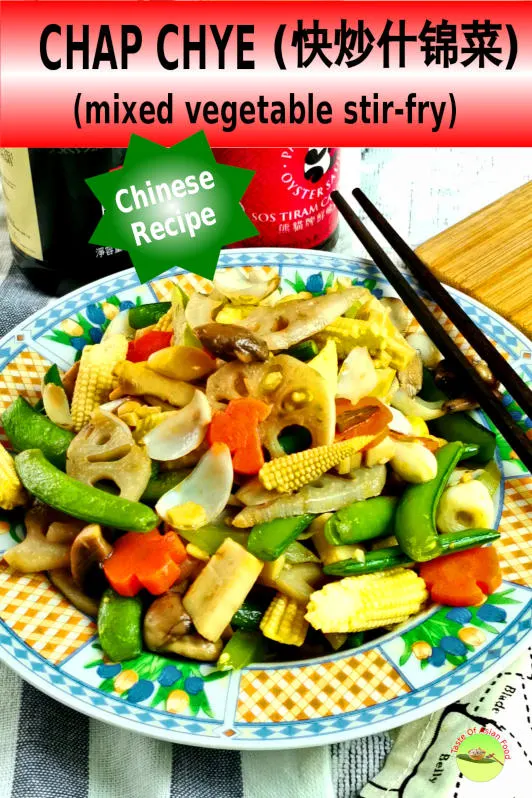
Note: This post may contain affiliate links. Please read my privacy policy for more info. I may receive commissions for purchases made through links in this post. As an Amazon Associate, I earn from qualifying purchases.
The basic principles to stir-fry chap chye
Most of the ingredients in this recipe are readily available in most of the supermarkets in Asia. However, you may need to go to the Asian grocery store to purchase them if you live in Western countries.
You can use any vegetables other than in this recipe. Do explore and make changes based on what you have on hand.
The key is to use mainly crunchy and tender-crisp vegetables and follow a set of fundamental principles to get the best result.
1. Create a colorful vegetarian dish
The main ingredients in this recipe are lotus root, carrots, baby corn, bamboo shoot, and sweet peas. You can immediately note that this combination provides vibrant colors of brown, red, yellow, and green.
2. Use vegetables with different shapes to make it visually appealing
Lotus root has a unique pinwheel shape. Baby corn, mushrooms, celery, and ginkgo nuts all have unique shapes and colors. The stir-fry is extraordinarily presentable and attractive.
3. Used vegetables with difference textures
Lotus root has a dense and crunchy texture, ginkgo nuts and mushrooms are soft and chewy. The bamboo shoots and the lily bulb are tender-crisp. You have all the elements in one dish to tickle your taste buds.
4. Ingredients with difference flavors
Lotus root is nutty, carrots and baby corn are sweet, celery has his distinct savory flavor, while ginkgo nuts have a tinge of bitterness. You can imagine what the mouthfeel is when all these are eating and chewing at the same time!
A brief explanation of some less common vegetables
Some of the vegetables in this recipe may be less common to certain people who do not cook Chinese food often. You can keep this section if you are proficient in Chinese cooking, but this serves as a brief guide if you are the first time handling these vegetables.
Lotus root 莲藕
Lotus root is an oblong-shaped tubular rhizome that grows underground. The flesh underneath the yellowish skin has ivory to white color. Its texture is crisp, light, and turn starchy if you boil it for a long time. It is perfect for stir-fry as it has a crunchy texture if you stir-fry It briefly.
- Remove the skin and cut it into thin slices for stir-frying.
- After slicing it into slices, it will review the flesh’s pinwheel shape, which is extremely attractive for food presentation.
- It is best to parboil the lotus root before stir-frying to shorten the stir-fried time.
Bamboo shoots 竹笋
Bamboo shoots are two weeks old bamboo harvest before they grow into full height.
It is widely available in canned or vacuum packed in the supermarket. The bamboo shoots’ fibrous outer layers have been removed and clean for canned or vacuum packs sold in the grocery stores. It is also ready to eat and does not require cooking. If you buy the raw one, you need to cook it for 20 minutes to remove its bitter taste.
The bamboo shoot has a crisp-tender texture close to asparagus.
Ginkgo nuts 白果
I use the ready-to-eat vacuum pack ginkgo nuts for convenience. If you want to use the fresh nuts (which has a more robust nuts flavor), break the nuts with a small hammer, remove the hard shell and peel off the thin skin. Remove the inner stem, which is bitter.
Ginkgo nut has a soft, squishy texture. Its taste is slightly sweet with a bitter undertone.
Lily bulbs 百合
The shape of the lily bulb looks like a small shallot. When cut, the petals will fall off like the layers of the onion. It has a slightly presumed smell, slightly crunchy (like onions) with a delicate, sweet flavor.
How to prepare chap chye- step by step
Now last get into the details on how to prepare the ‘chap chye.’ The process involves three steps- cuts the vegetables, prepares the sauce, and stir fry.
1. Prepare the vegetables
- Lotus roots. Cut off both ends of a section of the lotus root. Peel off the skin and cut it into thin slices. Sook it in water to prevent it from changing color if you do not use it immediately. Parboil the lotus roots in water for two minutes to shorten the time required for Stir-frying.
- Carrot. Peel and cut the carrot into slices, just like the lotus root. It is also good to parboil it because the carrot is hard compared with other ingredients.
- Baby corn. Cut it on a bias into two to three sections for quick stir-frying.
- Lily bulb. Clean the lily bulbs and loosen the petals.
- Celery. Cut it into slices diagonally.
- Garlic sprouts. I use some garlic sprouts because I have it in the refrigerator. It is optional, but it offers some extra crunch (taste like the tender-crisp french bean).
- Button mushrooms. You can also use dry shiitake mushroom for extra aroma and flavor, and king oyster mushroom for its crunchy texture.
- Bamboo shoot and ginkgo nuts. The canned and vacuum-packed type can be used straight out of the packaging. I boil the bamboo shoot in water for a minute to remove the brine, ensure there is no unwanted raw smell, and then cut the bamboo shoots into thin slices.
- Sweet peas. Tip snap both ends of the sweet peas and then pull along the pod to remove both sides’ strings. You can parboil it for half a minute if you wish.
2. Make the stir-fry sauce
This combination of vegetables has a diverse flavor and texture. The goal of the seasoning is to enhance their natural flavor rather than overshadow it. Therefore, I season the chap chye lightly with oyster sauce, soy sauce, salt, and sugar and thicken the stir-fried with cornstarch slurry.
Since stir-fried is a quick and continuing process, I highly recommend premixing these seasoning ingredients instead of adding them one by one during the stir-frying time.
3. Stir-fry the vegetables
Once you have done all the mise en place, it is time for 5 minutes of quick stir-trying to complete the chap chye.
Here are the detailed steps:
- Heat some oil in a pan or a well-seasoned wok.
- Add some coarsely chopped garlic over low heat, and saute it until aromatic.
- Add all the ingredients into the wok and start to stir fry. The sequence is not very important because those ingredients that are supposed to take a longer time to stir-fry have been cooked partially.
- I usually start by adding the celery, lily bulbs, and baby corn, followed by partially cooked ingredients. Next, pour in all the remaining ingredients and mix well.
- Push the vegetables to the edge of the wok to create some space at the bottom. Pour in the seasoning mixture and give it a slow stir until the corn starch thickens. !
- Push the vegetable back to the center and turn up the heat to the highest.
- Stir-fried over roaring heat to create the wok aroma.
- The duration of stir-frying depends on the amount of food and the heat generated. As the rule of thumb, it is done when there is no visible liquid remaining in the wok, and all the morsels of food are heated up, and smoke wafting from the wok.
- Dish out and serve immediately.
Other popular vegetable stir-fry recipe (let’s try it!)
There are different stir-fries with various combinations of vegetables in China. I published a Chinese stir-fried vegetable recipe a few years ago, which has become one of the most popular recipes on this blog. This recipe is an adaptation of what we served in our restaurant, consisting of broccoli, cauliflower, bell pepper, and carrot.
The flavor and texture are fundamentally different from the chap chye in this article. You can access to this popular recipe over here.
Chap Chye ( stir fry delicious crunchy vegetables)
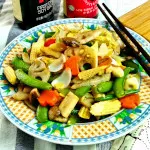
This Chap Chye stir-fry recipe ( 炒杂菜/ 快炒什锦菜/chap choy) is an attractive vegetable stir-fry popular in every Chinese household. It is multi-colored, tender-crisp, and is a combination of vegetables with different texture and flavor.,
Ingredients
Main ingredients (A)
- 300g (1 oz) lotus root, cut into thin slices
- 70g (2oz) carrot, cut into slices
- 80g (2.5 oz) baby corn, cut into short sections
- 4 lily bulbs, loosen the petals
- 1/2 (40g) stalk celery, cut into slices
- 2 stalks garlic sprouts, cut into one-inch sections
- 4 button mushrooms
- 60g (2oz) bamboo shoot
- 30g (1 oz) ginkgo nut
- 90g (3oz) snow peas, remove the fibrous strings
Seasonings (B)
- 1 tbsp of oyster sauce (or the mushroom extract of vegetarian)
- 2 tsp of light soy sauce
- 1 tsp of sugar
- 1/2 tsp of sugar
- 1 tsp of cornstarch
- 5 tbs of water
Other ingredients (C)
- 1 tbsp coarsely chopped garlic
- 2 tbsp cooking oil for stir-frying
Instructions
Prepare the vegetables
- Get ready all the vegetables in A and cut according to the short direction in the ingredient section.
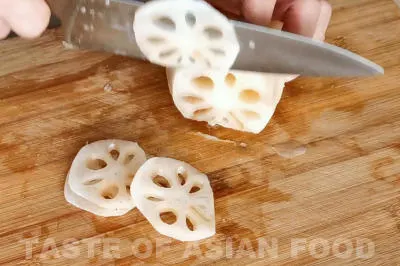
- Blanch the lotus root, carrot, bamboo shoot in boiling water for 2 minutes, add the sweet peas, and wait until the water comes to a boil again. Drain and set aside. Cut the blanched bamboo shoot into slices
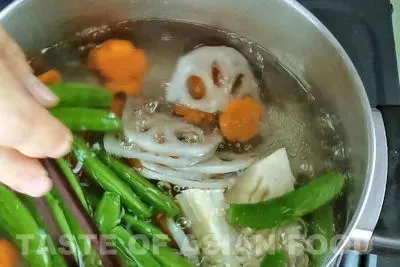
Stir-frying
- Saute the chopped garlic in oil until aromatic. Add all the ingredients in A into the wok one by one, flip and mix until they are all heated up.
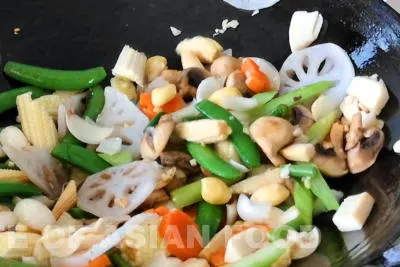
- Mix all the ingredients in B, and add to the vegetables.
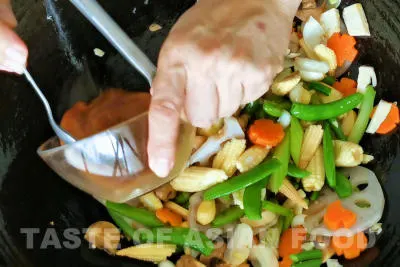
- Stir fry over high heat until the gravy is thickened and is about to dry.
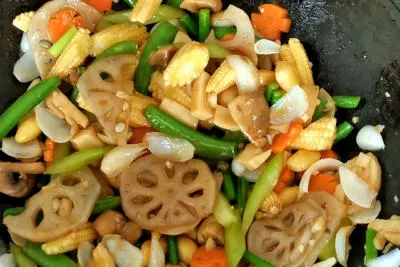
Recommended Products
As an Amazon Associate and member of other affiliate programs, I earn from qualifying purchases.
Nutrition Information:
Yield:
4Serving Size:
1Amount Per Serving: Calories: 578Total Fat: 14gSaturated Fat: 1gTrans Fat: 0gUnsaturated Fat: 11gCholesterol: 0mgSodium: 300mgCarbohydrates: 111gFiber: 14gSugar: 25gProtein: 19g
This data was provided and calculated by Nutritionix on 9/13/2020

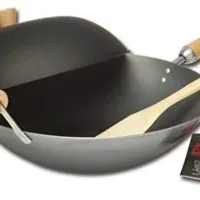

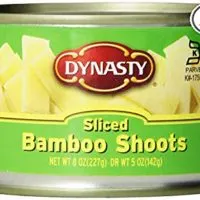
Faith
Thursday 11th of November 2021
May I know if there's any way to stir fry your vegetables recipes without using oyster sauce or other sauces such as hosin sauce as I can't find them overseas. I realize that many recipes use oyster sauce. Thanks
KP Kwan
Friday 12th of November 2021
You can use the vegetarian 'oyster sauce' as the substitute. It's made with mushroom extract but tastes like oyster sauce. Please ask your local Asian grocery shop. The brand Lee Kum Kee produces it, or you can get it from Amazon online.
Alternatively, omit the oyster sauce, use light soy sauce plus a small amount of sugar as the substitute.
susan
Tuesday 15th of September 2020
I lived in KL for years and never heard of chap chye.. does this dish comes in a local name ?
KP Kwan
Wednesday 16th of September 2020
Hi Susan, It is 炒杂菜/ 快炒什锦菜. I hope the English translation does not make you confused :) KP Kwan
KP Kwan
Tuesday 15th of September 2020
Hi, this is KP Kwan. I am happy to see you in this comment area, as you have read through my recipe. I am pleased to reply to any questions and comments as soon as possible.